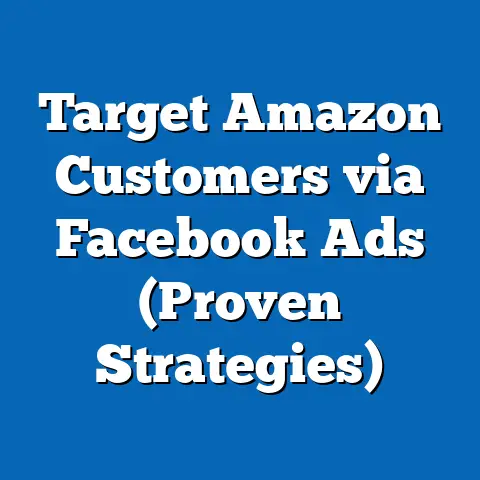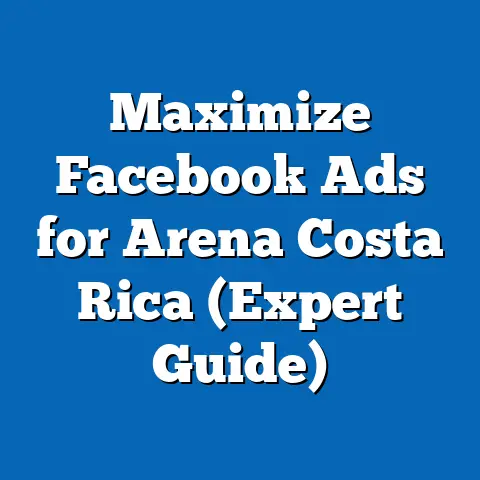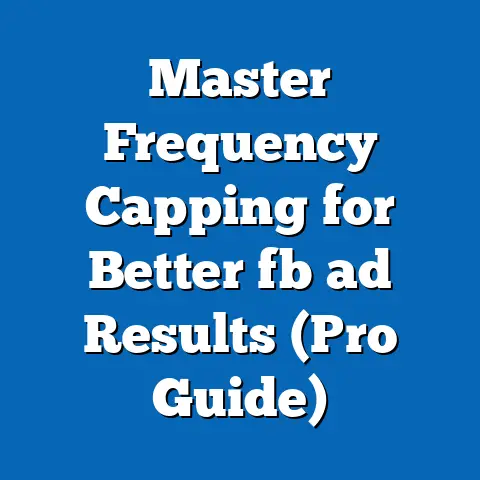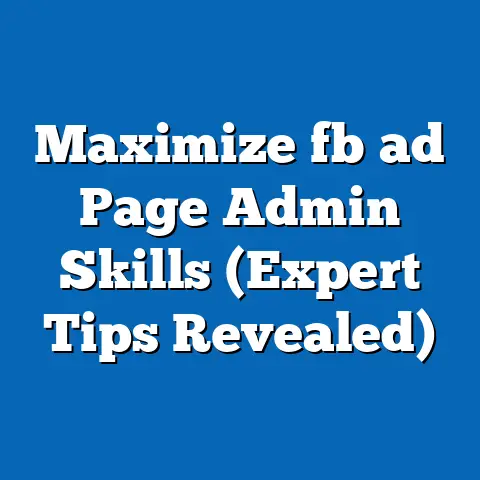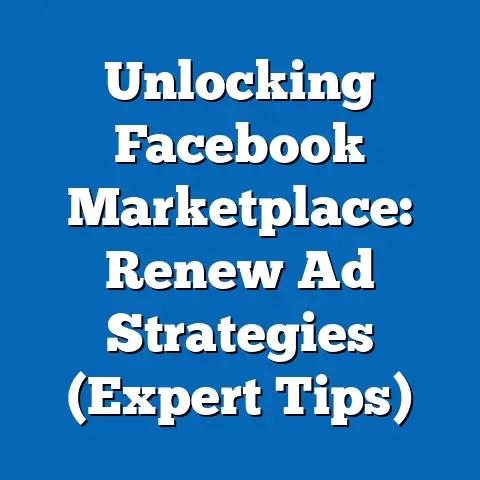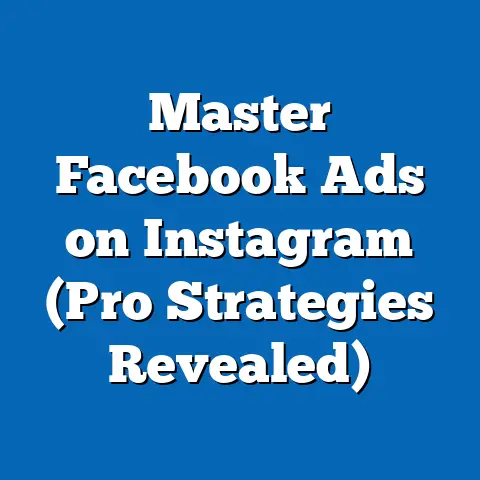Boost Business with Effective Facebook Ads (Pro Strategies)
I remember when I first started experimenting with Facebook Ads. I was running a small online store selling handmade jewelry, and I was struggling to get my products in front of the right audience. Traditional advertising felt like shouting into a void, but Facebook Ads promised a way to target my ideal customers with laser precision.
One of my first clients, a local bakery, initially saw Facebook as “just for kids.” They were hesitant to invest, but after showing them how hyper-local targeting could bring in customers from their immediate neighborhood, they decided to give it a try. Within three months, they saw a 300% increase in revenue – a testament to the power of well-executed Facebook advertising! That’s the kind of impact I want to help you achieve.
Facebook, now under the Meta umbrella, remains a powerhouse for marketing, boasting billions of active users. But simply throwing money at the platform won’t guarantee success. You need a strategic approach, a deep understanding of the ecosystem, and a willingness to constantly learn and adapt. In this guide, I’ll walk you through the pro strategies I’ve used to help businesses of all sizes achieve remarkable results with Facebook Ads.
Understanding the Facebook Advertising Ecosystem
Before diving into the nitty-gritty of ad creation and targeting, it’s crucial to understand the landscape. The Facebook advertising ecosystem is vast and complex, but breaking it down into its core components makes it much more manageable.
- Ad Formats: Facebook offers a variety of ad formats, from simple image ads to engaging video ads, carousels, and collections. Each format has its strengths and weaknesses, and the best choice depends on your specific goals and target audience.
- Targeting Options: This is where Facebook truly shines. You can target users based on demographics (age, gender, location), interests, behaviors, connections, and even custom audiences built from your own customer data. The more precise your targeting, the more effective your ads will be.
- Facebook Ads Manager: This is your control center for creating, managing, and analyzing your Facebook ad campaigns. It’s where you’ll set your budget, choose your targeting options, design your ads, and track your performance.
Understanding your audience is paramount. Who are they? What are their interests? What are their pain points? The more you know about your target audience, the better you can tailor your ads to resonate with them. Facebook’s targeting capabilities are incredibly powerful, allowing you to reach specific segments of your audience with personalized messages.
Takeaway: Familiarize yourself with the different ad formats, targeting options, and the Facebook Ads Manager. Conduct thorough audience research to understand your ideal customer.
Crafting Compelling Ad Creative
No matter how precise your targeting is, your ads will fall flat if the creative isn’t compelling. Think of your ad as a mini-story, a visual invitation, or a solution to a problem. It needs to grab attention, convey a clear message, and inspire action.
- Visual Appeal: High-quality images and videos are essential. Use visuals that are relevant to your product or service and that resonate with your target audience. Avoid stock photos that look generic and try to use authentic images or videos that showcase your brand’s personality.
- Engaging Copywriting: Your ad copy should be concise, clear, and persuasive. Highlight the benefits of your product or service, address your audience’s pain points, and create a sense of urgency. Use strong calls to action that tell people exactly what you want them to do.
- Alignment: Your ad content should be closely aligned with your target audience’s interests and pain points. Speak their language, address their needs, and show them how your product or service can solve their problems.
I’ve found that testing different ad creatives is crucial. Try different images, headlines, and calls to action to see what resonates best with your audience. Don’t be afraid to experiment and think outside the box. Sometimes, the most unexpected ads are the most successful.
Takeaway: Invest in high-quality visuals and compelling copywriting. Align your ad content with your target audience’s interests and pain points. A/B test different creatives to optimize performance.
Utilizing Facebook Pixel for Enhanced Tracking
The Facebook Pixel is a small snippet of code that you place on your website. It acts as a bridge between your website and Facebook, allowing you to track user interactions and measure the effectiveness of your ad campaigns. Think of it as your own little data-gathering robot.
- Tracking User Interactions: The Pixel tracks events such as page views, add-to-carts, purchases, and form submissions. This data provides valuable insights into how users are interacting with your website and how your ads are driving conversions.
- Retargeting Ads: The Pixel allows you to retarget users who have visited your website or interacted with your ads. This means you can show ads specifically to people who have shown interest in your products or services, increasing the likelihood of a conversion.
- Optimizing Campaigns: The Pixel provides data that you can use to optimize your advertising campaigns. By tracking conversions and other key metrics, you can identify which ads are performing well and which ones need improvement.
I’ve seen firsthand how the Facebook Pixel can transform ad campaigns. For one of my e-commerce clients, we used the Pixel to track purchases and create retargeting ads for users who had abandoned their carts. This simple strategy resulted in a 20% increase in sales.
Takeaway: Install the Facebook Pixel on your website. Use it to track user interactions, retarget users, and optimize your advertising campaigns.
Advanced Targeting Strategies
While basic demographic targeting is a good starting point, the real power of Facebook Ads lies in its advanced targeting capabilities. Here are a few strategies I’ve found particularly effective:
- Lookalike Audiences: This allows you to create audiences that are similar to your existing customers. Facebook analyzes the characteristics of your customer base and finds other users who share similar traits. This is a great way to expand your reach and find new customers who are likely to be interested in your products or services.
- Custom Audiences: This allows you to upload your own customer data (email addresses, phone numbers) and target those users directly on Facebook. This is a great way to reach existing customers with special offers or announcements.
- Behavior and Interest Targeting: This allows you to target users based on their interests, hobbies, and online behavior. This is a great way to reach people who are passionate about your industry or who are actively searching for products or services like yours.
- Detailed Demographic Targeting: Go beyond age and gender. Target based on education level, relationship status, job title, and more. Layering these demographics gives you incredibly granular control.
Segmenting your audiences based on behavior and interests is crucial for improving ad relevance and engagement. For example, if you’re selling running shoes, you could target users who are interested in running, fitness, and outdoor activities. You could also target users who have recently purchased running shoes from your competitors.
Takeaway: Explore advanced targeting techniques such as lookalike audiences, custom audiences, and behavior and interest targeting. Segment your audiences to improve ad relevance and engagement.
Budgeting and Bidding Strategies
Setting the right budget and choosing the right bidding strategy are essential for maximizing your ROI on Facebook Ads. Here’s a breakdown of some key considerations:
- Daily vs. Lifetime Budgets: A daily budget sets a specific amount that you’re willing to spend each day. A lifetime budget sets a total amount that you’re willing to spend over the entire duration of your campaign. The best choice depends on your goals and how much control you want over your spending.
- Bidding Options (CPC, CPM, CPA):
- CPC (Cost Per Click): You pay each time someone clicks on your ad. This is a good option if you’re focused on driving traffic to your website.
- CPM (Cost Per Mille): You pay for every 1,000 impressions your ad receives. This is a good option if you’re focused on brand awareness.
- CPA (Cost Per Acquisition): You pay each time someone completes a desired action, such as making a purchase or filling out a form. This is a good option if you’re focused on driving conversions.
- Budget Scaling: Start with a smaller budget to test your ads and targeting. Once you identify what’s working, gradually increase your budget to scale your results.
- CPC (Cost Per Click): You pay each time someone clicks on your ad. This is a good option if you’re focused on driving traffic to your website.
- CPM (Cost Per Mille): You pay for every 1,000 impressions your ad receives. This is a good option if you’re focused on brand awareness.
- CPA (Cost Per Acquisition): You pay each time someone completes a desired action, such as making a purchase or filling out a form. This is a good option if you’re focused on driving conversions.
Choosing the right bidding option depends on your campaign goals. If you’re focused on driving traffic, CPC is a good choice. If you’re focused on brand awareness, CPM is a better option. If you’re focused on driving conversions, CPA is the most effective choice, but it requires more data and optimization.
Takeaway: Choose the right budgeting and bidding strategies based on your campaign goals. Start with a smaller budget and gradually increase it as you optimize your campaigns.
A/B Testing for Continuous Improvement
A/B testing, also known as split testing, is the process of comparing two versions of an ad to see which one performs better. This is a crucial part of optimizing your Facebook advertising campaigns.
- Elements to Test: You can test different elements of your ads, such as:
- Ad Copy: Try different headlines, descriptions, and calls to action.
- Images: Test different images and videos to see which ones resonate best with your audience.
- Targeting: Experiment with different targeting options to see which audiences are most responsive.
- Placement: Test different ad placements (e.g., Facebook News Feed, Instagram Feed, Audience Network) to see which ones deliver the best results.
- Analyzing Results: Use Facebook Ads Manager to track the performance of your A/B tests. Pay attention to metrics such as click-through rate (CTR), conversion rate, and cost per acquisition (CPA).
- Ad Copy: Try different headlines, descriptions, and calls to action.
- Images: Test different images and videos to see which ones resonate best with your audience.
- Targeting: Experiment with different targeting options to see which audiences are most responsive.
- Placement: Test different ad placements (e.g., Facebook News Feed, Instagram Feed, Audience Network) to see which ones deliver the best results.
I always recommend testing one element at a time to isolate the impact of each change. For example, if you’re testing two different headlines, keep everything else the same. This will allow you to accurately determine which headline is more effective.
Takeaway: Make A/B testing a regular part of your Facebook advertising strategy. Test different elements of your ads and analyze the results to refine your strategies.
Leveraging Facebook Insights for Data-Driven Decisions
Facebook Insights provides a wealth of data about your ad performance, your audience, and your overall marketing efforts. It’s like having a magnifying glass that lets you see exactly what’s working and what’s not.
- Tracking Ad Performance: Facebook Insights allows you to track key metrics such as:
- Click-Through Rate (CTR): The percentage of people who see your ad and click on it.
- Conversion Rate: The percentage of people who click on your ad and complete a desired action (e.g., making a purchase).
- Engagement: The number of likes, comments, and shares your ad receives.
- Interpreting Key Metrics: Understanding these metrics is crucial for optimizing your campaigns. A low CTR might indicate that your ad creative isn’t compelling enough. A low conversion rate might indicate that your landing page isn’t optimized.
- Click-Through Rate (CTR): The percentage of people who see your ad and click on it.
- Conversion Rate: The percentage of people who click on your ad and complete a desired action (e.g., making a purchase).
- Engagement: The number of likes, comments, and shares your ad receives.
I’ve found that regularly monitoring Facebook Insights is essential for making data-driven decisions. For one of my clients, we noticed that their ads were performing well on mobile devices but not on desktop computers. We optimized their landing page for mobile users and saw a significant increase in conversions.
Takeaway: Use Facebook Insights to track your ad performance and make data-driven decisions. Pay attention to key metrics such as CTR, conversion rate, and engagement.
Optimizing Ads for Mobile Users
With the majority of Facebook users accessing the platform via mobile devices, optimizing your ads for mobile users is more important than ever.
- Mobile-First Design: Design your ads with mobile users in mind. Use vertical videos, short and concise copy, and clear calls to action.
- Mobile-Optimized Landing Pages: Ensure that your landing pages are optimized for mobile devices. They should load quickly, be easy to navigate, and provide a seamless user experience.
- Mobile Ad Formats: Take advantage of mobile-specific ad formats such as Instant Experiences, which provide a full-screen, immersive experience for mobile users.
I’ve seen firsthand how optimizing for mobile can improve ad performance. For one of my clients, we switched from horizontal videos to vertical videos and saw a 30% increase in engagement.
Takeaway: Optimize your ads and landing pages for mobile users. Use mobile-first design principles, ensure fast loading times, and take advantage of mobile-specific ad formats.
Case Studies of Successful Facebook Ad Campaigns
Let’s take a look at a few real-world examples of businesses that have successfully implemented Facebook Ads:
- Local Restaurant: A local restaurant used Facebook Ads to target users within a 5-mile radius of their location. They ran ads featuring mouthwatering photos of their food and special offers. This resulted in a 25% increase in foot traffic.
- E-commerce Store: An e-commerce store used Facebook Ads to retarget users who had abandoned their carts. They showed these users ads featuring the products they had left behind, along with a discount code. This resulted in a 20% increase in sales.
- Online Course Provider: An online course provider used Facebook Ads to target users who were interested in their course topics. They ran ads featuring testimonials from satisfied students and a free trial offer. This resulted in a 15% increase in enrollments.
What can we learn from these case studies? First, targeting is key. The more specific your targeting, the more effective your ads will be. Second, compelling creative is essential. Your ads need to grab attention and convey a clear message. Third, A/B testing is crucial for optimizing your campaigns. You need to constantly experiment and refine your strategies to see what works best.
Takeaway: Study successful Facebook Ad campaigns to learn best practices and apply them to your own advertising efforts.
Conclusion
Facebook Ads can be a powerful tool for boosting your business, but it requires a strategic approach and a willingness to learn and adapt. By understanding the Facebook advertising ecosystem, crafting compelling ad creative, utilizing the Facebook Pixel, implementing advanced targeting strategies, setting the right budget, A/B testing your ads, leveraging Facebook Insights, and optimizing for mobile users, you can achieve remarkable results.
Remember, consistent testing, learning, and adapting are crucial for long-term success on the platform. Don’t be afraid to experiment and try new things. The world of Facebook advertising is constantly evolving, so it’s important to stay up-to-date on the latest trends and best practices.
Call to Action
Ready to take your Facebook advertising to the next level? Start by creating your first campaign or optimizing your existing ones. Explore the resources available on the Facebook Business website and stay updated on the latest trends in digital marketing. The potential for growth is immense, and with the right strategies, you can unlock the power of Facebook Ads to transform your business.
Remember that bakery I mentioned at the beginning? They didn’t just stop at that initial success. They continued to refine their strategy, experiment with new ad formats, and stay engaged with their audience. And that’s the key – continuous improvement. So, dive in, experiment, and watch your business flourish!

